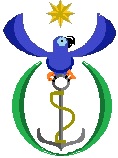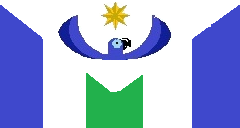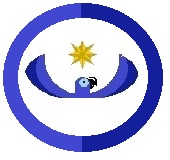Navy of The Oan Isles

Naval Emblem

Naval Ensign
%between%
Headquarters
Founded: 1945 July 1
The Navy of the Oan Isles is the marine component of the armed forces.
Commanders
Commander-in-chief: Defender of the Oan Isles, H.E. Lieutenant Chief Ese Ulua
Minister of Defence: The Hon. General Oaluoa Uye
Marshal of War: General Aloa Uataka
Marshal of the Sea: General Tiyene ta Viyere
Deployment
Oan fleets and troops are mostly presently deployed in Oan territorial waters. When the Central and Eastern Fleet are fully active they will be deployed to the area between The Oan Isles proper and Gondwana. Upon the eventual colonisation of the South West Gondwana, a small group will be stationed in the Gulf of Gondwana.
In 2017, General Oaluoa Uye attempted to deploy troops to further Oan expansion, but failed to gain the necessary legal authorisation or financial support and wad stopped around the 180 degrees longitude line. This was called Operation Conquer Gondwana. A map of the present and proposed deployments will be published herr soon.
Organisation and capabilities
The Navy is made up of five fleets. Each fleet has a specialised function and geographic distribution.
The Western Fleet is responsible for combat. It currently absorbs the bulk of the expeditionary role. The Central and the Eastern Fleet are currently planned and are coming into fruition. They will be completed in a short time. The core of the Western Fleet (and as the planned fleets will also have) is the air craft carrier strike group. The TOIS Salvation is currently the only air craft carrier. It is a Commonwealth Class ship according to the design designation of the company that produced it. It is supported by a number of ships such as destroyers and cruisers. Other strike groups are organised and deployed in a similar fashion. The construction of the TOIS Liberty and the TOIS Justice nuclear air craft carriers will significantly expand the expeditionary capabilities of the Oan Defence forces. The ability to deploy over long distances and long periods of time has been a major drawback. The Liberty and Justice ships will expand the ability of the Navy to deploy over long distances and periods of time and allow more manpower and materiel to be moved than ever before, especially where the Oan Isles’s expansion into the Central and Eastern parts of the Pacific is concerned. The Home Islands of the Oan Isles are, however well defended.
Small groups of fifteen to twenty vessels among which are destroyers and cruisers are deployed evenly under the main fleet headquarters which are housed in one of three naval bases. These small teams or strike groups help to project power of a large area, moving quickly and effectively. Because conventional invasionary war has never seemed like a likely possibility, the Western Fleet has focused on prevention of war.
The Second and First Coast Guard Fleets form the rudimentary concept of a “Coast Guard”. They are largely used for non combat operations against another power at sea. They are focused on law enforcement, search and rescue, disaster relief, counter terrorism an piracy and anti poaching. This means that they largely work in tandem with civilian bodies such as the Police, Border Patrol, Emergency Services and Anti Poaching Service, while remaining an entirely military entity. They provide most of the support function of the Western (and soon to be Eastern and Central Fleets) such as transport, medical help and replenisment.
The Amphibious Fleet is responsible for highly specialised operations in a plethora of situations. If forms what is known as the Marines. Unlike the other parts of the Navy, it has aircraft which it uses more freely and directly than other components can. It forms the main muscle of the Special Operations Command or SOCOM which handles very difficult situations that might prove more tricky for other bodies to get their heads around. It has the power to work on land, sea and sky, but mainly from the sea.
Ships and submarines
It currently has 133 ships (including commissioned and auxilliary vessels). It has 53 planned ships. It has 46 submarines and plans to double this in two years. The Shipyards of The Oan Isles is responsible for building ships for the military.
Diesel-electric submarines were discontinued in 1990 and all air propulsion submarines were discontinued in 2000.
Current resources
Western Fleet
1 air craft carrier
5 cruisers
2 destroyers
5 large patrol vessels
10 minor surface combat vessels
2 mine warfare vessels
1 surveillance and intelligence vessel
First Coast Guard Fleet
1 command and support vessel
15 minor surface combat vessels
10 large patrol vessels
8 search and rescue vessels
1 hospital ship
1 surveillance and intelligence vessel
3 replenishment vessels
Second Coast Guard Fleet
1 command and support vessel
15 minor surface combat vessels
10 large patrol vessels
8 search and rescue vessels
2 hospital ships
1 surveillance and intelligence vessels
2 replenishment vessels
Amphibious Fleet
1 command vessel
10 large patrol vessels
2 docking ships
5 landing ships
2 surveillance and intelligence vessels
10 amphibious vessels
First Submarine Force
5 ballistic missile submarines
10 guided missile submarines
7 nuclear attack submarines
15 alternative fuel-electric submarines
8 special mission submarine
Planned expansion within 2 years
Central Fleet
1 air craft carrier
6 destroyers
2 large patrol vessels
10 minor surface combat vessels
3 mine warfare vessels
1 surveillance and intelligence vessel
Eastern Fleet
1 air craft carrier
5 cruisers
2 destroyers
7 large patrol vessels
10 minor surface combat vessels
5 mine warfare vessels
Second Submarine Force
5 ballistic missile submarines
10 guided missile submarines
7 nuclear attack submarines
15 alternative fuel-electric submarines
8 special mission submarine



